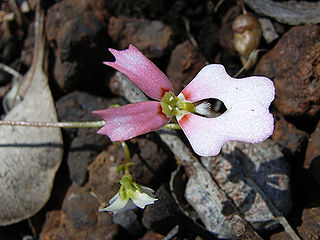
Stylidium is a genus of dicotyledonous plants that belong to the family Stylidiaceae. The genus name Stylidium is derived from the Greek στύλος or stylos, which refers to the distinctive reproductive structure that its flowers possess. Pollination is achieved through the use of the sensitive "trigger", which comprises the male and female reproductive organs fused into a floral column that snaps forward quickly in response to touch, harmlessly covering the insect in pollen. Most of the approximately 300 species are only found in Australia, making it the fifth largest genus in that country. Triggerplants are considered to be protocarnivorous or carnivorous because the glandular trichomes that cover the scape and flower can trap, kill, and digest small insects with protease enzymes produced by the plant. Recent research has raised questions as to the status of protocarnivory within Stylidium.
Juliet Ann Wege is an Australian botanist. She graduated in 1992 and gained a PhD at The University of Western Australia in 1999 with a thesis titled "Morphological and anatomical variation within Stylidium (Stylidiaceae): a systematic perspective". As of 2021 she works as a researcher at the Western Australian Herbarium run by Western Australia's Department of Biodiversity, Conservation and Attractions and is managing editor of Nuytsia. Her main area of expertise is in taxonomy and study of the Stylidiaceae family of triggerplants.

Stylidium repens, the matted triggerplant, is a dicotyledonous plant that belongs to the genus Stylidium. S. repens is endemic to Australia and is found primarily in southwest Western Australia. This species is a creeping or scrambling triggerplant, which can spread over large areas as a tangled mat of stems and aerial roots. The older stems are grey whereas younger stems appear red and have terminal rosettes of small leaves, five mm to one cm in length. When the rains come, new roots and a one to three flowers emerge from the terminal rosettes. This is the only species of triggerplant known to regularly flower twice a year—in autumn and late spring. Pollination, which is typically very specialized in this genus, is achieved with a variety of insects in this species.

Tolypangium is a subgenus of the genus Stylidium that is characterized by ovoid to longish capsules. This subgenus was part of the earliest taxonomic division among the triggerplants. Stephan Ladislaus Endlicher first split the genus into two subgenera in 1838: Tolypangium with its ovoid capsules and Nitrangium with its linear capsules. Subsequent authors generally followed this classification, which is based almost entirely on the features of the capsule. Recent genetic analysis, combined with an exhaustive morphological comparison, has revealed that the classification defined by Johannes Mildbraed in 1908 is not the most accurate description of how the members of different subgenera and sections are related. As part of the Flora of Australia series, Juliet Wege will be reviewing and updating the taxonomy of the Stylidiaceae.

Verticillatae is a section in the subgenus Tolypangium that is characterized by globose capsules. Recent genetic analysis, combined with an exhaustive morphological comparison, has revealed that the classification defined by Johannes Mildbraed in 1908 is not the most accurate description of how the members of different subgenera and sections are related. As part of the Flora of Australia series, Juliet Wege will be reviewing and updating the taxonomy of the Stylidiaceae.

Andersonia is a subgenus of Stylidium that is characterized by a linear hypanthium, recurved mature capsule walls, an erect and persistent septum, and many seeds. This subgenus occurs in areas of tropical northern Australia and into Southeast Asia and was named in honour of William Anderson, the surgeon and naturalist who sailed with James Cook.

Stylidium section Debilia is a taxonomic rank under Stylidium subgenus Tolypangium. In his 1908 monograph on the family Stylidiaceae, Johannes Mildbraed had established this section as Debiles. In 1999, A.R. Bean published a taxonomic revision of several sections in subgenus Tolypangium in which he renamed the section from Debiles to Debilia.

Levenhookia, also known as the styleworts, is a genus of ten recognized species in the family Stylidiaceae and is endemic to Australia. The genus is restricted to Western Australia almost exclusively with a few exceptions: L. pusilla's range extends into South Australia, L. dubia's range extends through South Australia into Victoria and New South Wales, L. sonderi is native only to Victoria, and L. chippendalei is also found in the Northern Territory.
Stylidium aceratum is a dicotyledonous plant that belongs to the genus Stylidium. It occurs within the south west region of Western Australia

Stylidium subg. Centridium is a subgenus of Stylidium that is characterized by a globose hypanthium, a stipitate brush-like stigma, and gynostemium mobility not produced by a sensitive hinged torosus but by the movement of a cunabulum. All species with the possible and doubtful exception of S. weeliwolli are annuals. This subgenus appears to be most closely related to the genus Levenhookia, which suggests an ancestral relationship. Centridium was first published by John Lindley in the 1839 publication, A Sketch of the Vegetation of the Swan River Colony. Lindley created this subgenus to distinguish species which did not fit into either of the two other subgenera that had existed at the time. He initially placed Stylidium calcaratum, the newly described Stylidium androsaceum, and Stylidium stipitatum into subgenus Centridium. His description of S. androsaceum turned out to be synonymous with S. calcaratum and S. stipitatum is a synonym of Levenhookia stipitata.
Stylidium ceratophorum is a dicotyledonous plant that belongs to the genus Stylidium. It is an annual plant that is endemic to the Kimberley region of Western Australia and northern parts of the Northern Territory. It attains a height of 12–30 cm with a basal rosette of small leaves. The leaves are petiolate, obovate, or lanceolate and are only 0.2–1 cm long. Solitary scapes are produced that bear golden yellow or orange flowers, 7–9 mm across. Its habitat has been reported as being sandy soils on creek margins in the presence of Stylidium rubriscapum and Stylidium diceratum or in river paperbark stands. S. ceratophorum appears similar to S. diceratum and may be confused with the species since they both have orange flowers. S. ceratophorum's corolla is twice as large as S. diceratum, though, as well as the deeply divided posterior corolla lobes of S. ceratophorum.
Stylidium diceratum is a dicotyledonous plant that belongs to the genus Stylidium. The specific epithet diceratum is Greek for "two horns", referring to the two appendages that are present on the bend of the gynostemium. It is an annual plant that grows from 15 to 35 cm tall. The longer leaves are lanceolate and the shorter ones are spathulate, forming a basal rosettes around the stem. The leaves are around 5–8 mm long and 0.2-2.5 mm wide. Inflorescences are around 6–15 cm long and produce flowers that are orange with dark orange and pink veins and bloom from June to August in their native range. S. diceratum is only known from the type location, which is at creek crossings on the road to Beverley Springs in the Kimberley region of Western Australia. Its habitat is recorded as being sandy soils on creek margins. It grows in the presence of S. ceratophorum, S. rubriscapum, Drosera caduca, D. paradoxa, Byblis liniflora, and Grevillea pteridifolia. S. diceratum is most closely related to S. longicornu, but it can be confused with S. ceratophorum, which also has an orange corolla but twice as large.
Stylidium edentatum is a dicotyledonous plant that belongs to the genus Stylidium. It is an annual plant that grows around 6 cm tall. The elliptical leaves form a basal rosettes around the stem. The leaves are around 0.3-0.8 mm long with recurved margins. Inflorescences are produced on solitary scapes and bear flowers that are white with rose-coloured markings at the base of the corolla lobes and two tooth-shaped throat appendages present. S. edentatum was a previously overlooked species that is related to and appears similar to S. calcaratum and S. ecorne. Allen Lowrie and Sherwin Carlquist described this species in 1989 and argued that if S. ecorne is considered distinct from S. calcaratum, then certainly S. edentatum warrants placement at the species level. It differs from S. calcaratum and S. ecorne by the long petioles on its recurved leaves, and the cuneate, obtuse, and unlobed posterior corolla lobes. They also have a distinctive lateral toothlike appendage at the base of each posterior corolla lobe. S. edentatum is endemic to southwestern Western Australia.
Stylidium weeliwolli is a dicotyledonous plant that belongs to the genus Stylidium. It occurs in the North West of Western Australia
Stylidium subg. Forsteropsis, as circumscribed by Allen Lowrie and Kevin Kenneally, contains five species of triggerplants from south-western Australia that are characterized by their tightly appressed leaves arranged in a spiral around the stem. This subgenus was originally described by Otto Wilhelm Sonder in 1845 as the genus Forsteropsis.
Stylidium imbricatum, the tile-leaved triggerplant, is a dicotyledonous plant that belongs to the genus Stylidium. It is an herbaceous perennial that grows from 12 to 50 cm tall and has divided stems covered with tile-like leaves that are arranged in a spiral formation around the stem. The ovate-elliptic leaves are basifixed and held closely against the stems. The leaves are around 1.5-1.8 mm long and 0.6-0.8 mm wide. Terminal inflorescences are racemose or spike-like and produce flowers that are reddish violet with laterally-paired lobes and bloom from April to May in their native range. S. imbricatum is only known from south-western Western Australia in Stirling Range National Park and Porongurup National Park south-east to Cheynes Beach. Its habitat is recorded as being sandy or laterite soils in swampy areas, rocky slopes, or heathland. S. imbricatum is distinct within its subgenus because it possesses obovate sepals. Its conservation status has been assessed as secure.
Stylidium leeuwinense is a species that belongs to the genus Stylidium. The specific epithet leeuwinense refers to the Cape Leeuwin region in Western Australia where the type location for this species is. It is an herbaceous perennial that grows from 15 to 60 cm tall and has divided stems covered with tile-like leaves that are arranged in a spiral formation around the stem. The lanceolate leaves are basifixed and held closely against the stems. The leaves are around 2.5-3.5 mm long and 0.5-0.8 mm wide. Terminal inflorescences are racemose or spike-like and produce flowers that are reddish purple with laterally-paired lobes and bloom from February to May in their native range. S. leeuwinense is only known from south-western Western Australia along the coast from Augusta to Denmark. Its habitat is recorded as being black, peat-sand soils in swampy areas or heathland. S. leeuwinense, along with S. preissii, is distinct within its subgenus because it possesses leaves without an apical mucro. It differs from S. preissii by its spike-like racemes.
Stylidium preissii, the lizard triggerplant, is a species that belongs to the genus Stylidium. It is an herbaceous perennial that grows from 5–18 cm tall and has divided stems covered with tile-like leaves that are arranged in a spiral formation around the stem. The broadly trullate leaves are basifixed and held closely against the stems. The leaves are around 1.9 mm long and 1.0 mm wide. Inflorescences are umbellate racemes and produce flowers that are white, pale pink, or dark pink and bloom from November to December in their native range. S. preissii is only known from south-western Western Australia from Bremer Bay to Israelite Bay with a few populations near Jandakot. Its habitat is recorded as being white sandy soils in open heathland. S. preissii is distinct within its subgenus because it possesses a strap-like gynostemium column with a dilated cunabulum.
Stylidium exappendiculatum is a species of dicotyledonous plant in the genus Stylidium.






